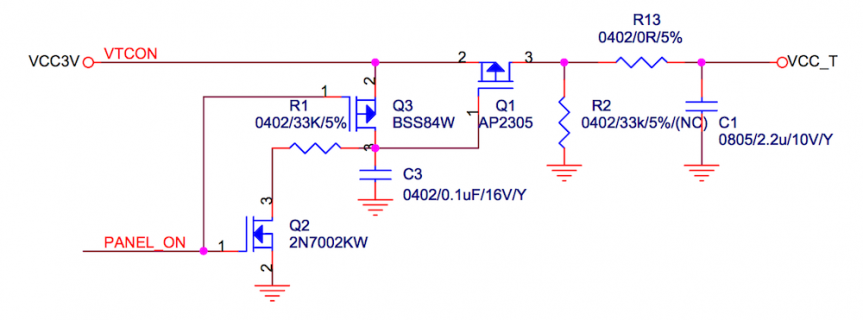I have the Adafruit e-paper display working with the teensy 3. I'm trying to make a board that has the example circuit for that epaper display. I'm trying to understand and perhaps simplify a specific part of this circuit:

The complete circuit diagram is here. The epaper display is spec'd to draw about 8mA, with a max inrush current of 40mA. It's a 3V device. In the portion above, I believe they are trying to switch the display power (VCC_T), which is 3.3V, using a control signal (PANEL_ON) from the microcontroller that might be 5V or even more, and moreover can source only a small amount of current.
In other parts of the circuit, they are using a single N-MOSFET as a level shifter. Here, however, they use this trio of FETs:
My question is: why three FETs and what do they each do? Why a FET with such a huge current capacity?
Moreover, if I know I'm driving this only from 3.3V logic, can I simplify this somewhat? This circuit already has a huge number of discrete components and I'd like to reduce if possible, but more I'd like to understand what's going on here.
I know this is probably elementary, but I'm not an EE so if you can provide references that might help me understand this circuit, I'd appreciate it.
Thanks!
-c

The complete circuit diagram is here. The epaper display is spec'd to draw about 8mA, with a max inrush current of 40mA. It's a 3V device. In the portion above, I believe they are trying to switch the display power (VCC_T), which is 3.3V, using a control signal (PANEL_ON) from the microcontroller that might be 5V or even more, and moreover can source only a small amount of current.
In other parts of the circuit, they are using a single N-MOSFET as a level shifter. Here, however, they use this trio of FETs:
- 2N7002KW is an enhancement mode N-MOSFET. Max drain current 310 mA and gate threshold voltage 1.1 - 2.1V.
- BSS84W is an enhancement mode P-MOSFET. Max drain current -130 mA, gate threshold voltage -0.8 - -2.0 V.
- AP2305GN is a P-Channel Enhancement MOSFET with a drain current of > 3 A and a gate threshold voltage -0.5 - -1.16 V.
My question is: why three FETs and what do they each do? Why a FET with such a huge current capacity?
Moreover, if I know I'm driving this only from 3.3V logic, can I simplify this somewhat? This circuit already has a huge number of discrete components and I'd like to reduce if possible, but more I'd like to understand what's going on here.
I know this is probably elementary, but I'm not an EE so if you can provide references that might help me understand this circuit, I'd appreciate it.
Thanks!
-c
Last edited:

